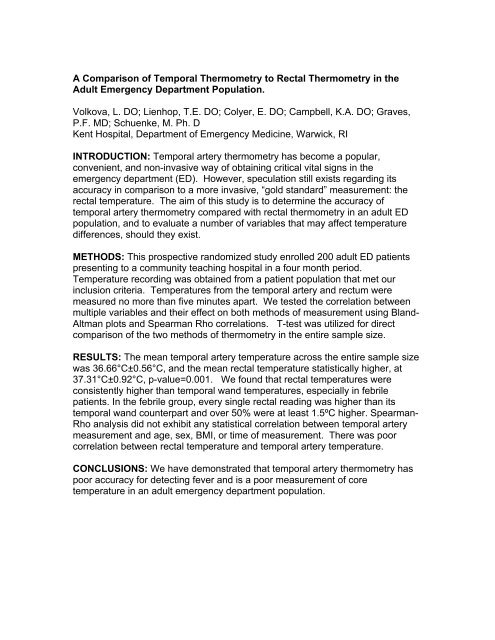Acute Flaccid Paralysis Accompanying West Nile Meningitis Ahmed ...
Acute Flaccid Paralysis Accompanying West Nile Meningitis Ahmed ...
Acute Flaccid Paralysis Accompanying West Nile Meningitis Ahmed ...
You also want an ePaper? Increase the reach of your titles
YUMPU automatically turns print PDFs into web optimized ePapers that Google loves.
A Comparison of Temporal Thermometry to Rectal Thermometry in the<br />
Adult Emergency Department Population.<br />
Volkova, L. DO; Lienhop, T.E. DO; Colyer, E. DO; Campbell, K.A. DO; Graves,<br />
P.F. MD; Schuenke, M. Ph. D<br />
Kent Hospital, Department of Emergency Medicine, Warwick, RI<br />
INTRODUCTION: Temporal artery thermometry has become a popular,<br />
convenient, and non-invasive way of obtaining critical vital signs in the<br />
emergency department (ED). However, speculation still exists regarding its<br />
accuracy in comparison to a more invasive, “gold standard” measurement: the<br />
rectal temperature. The aim of this study is to determine the accuracy of<br />
temporal artery thermometry compared with rectal thermometry in an adult ED<br />
population, and to evaluate a number of variables that may affect temperature<br />
differences, should they exist.<br />
METHODS: This prospective randomized study enrolled 200 adult ED patients<br />
presenting to a community teaching hospital in a four month period.<br />
Temperature recording was obtained from a patient population that met our<br />
inclusion criteria. Temperatures from the temporal artery and rectum were<br />
measured no more than five minutes apart. We tested the correlation between<br />
multiple variables and their effect on both methods of measurement using Bland-<br />
Altman plots and Spearman Rho correlations. T-test was utilized for direct<br />
comparison of the two methods of thermometry in the entire sample size.<br />
RESULTS: The mean temporal artery temperature across the entire sample size<br />
was 36.66°C±0.56°C, and the mean rectal temperature statistically higher, at<br />
37.31°C±0.92°C, p-value=0.001. We found that rectal temperatures were<br />
consistently higher than temporal wand temperatures, especially in febrile<br />
patients. In the febrile group, every single rectal reading was higher than its<br />
temporal wand counterpart and over 50% were at least 1.5ºC higher. Spearman-<br />
Rho analysis did not exhibit any statistical correlation between temporal artery<br />
measurement and age, sex, BMI, or time of measurement. There was poor<br />
correlation between rectal temperature and temporal artery temperature.<br />
CONCLUSIONS: We have demonstrated that temporal artery thermometry has<br />
poor accuracy for detecting fever and is a poor measurement of core<br />
temperature in an adult emergency department population.

















